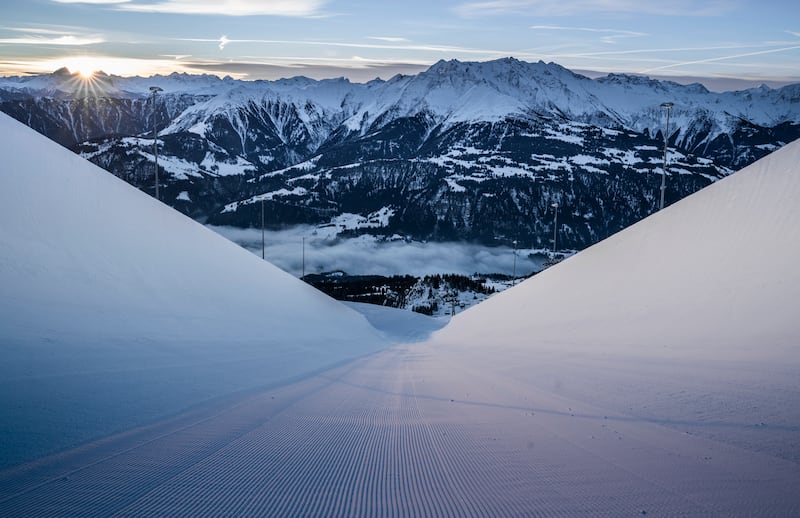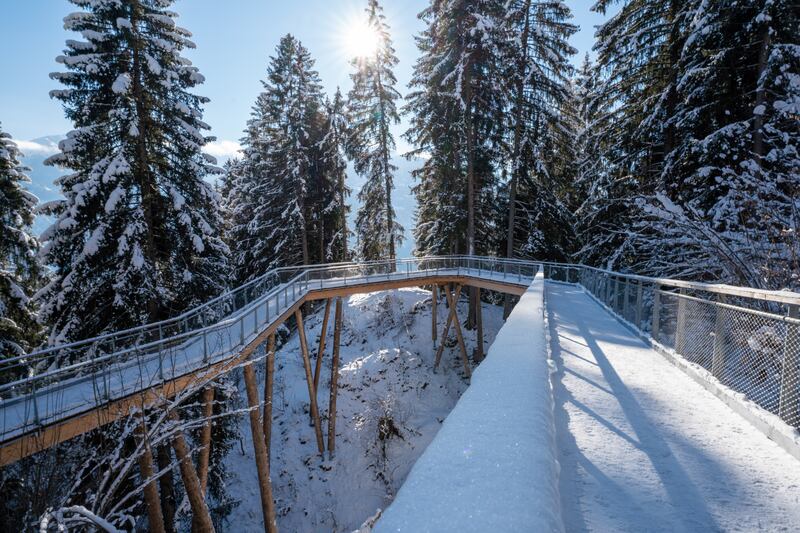The idea of a ski holiday seemed the most glamorous thing imaginable growing up in Limerick in the 1970s. James Bond movies from that era involved villain’s lairs revolving on a Swiss Alp or Roger Moore skiing backwards down a mountain, casually firing shots from his ski pole at the villain’s army following in hot pursuit.
A trip to the slopes back then seemed about as likely as a trip on Virgin Galactic nowadays. Delayed gratification is wonderful for the imagination, and I found myself building giant Lego ski slopes with cable cars running to a summit balanced on top of a tall bookcase. Not all those Lego cable cars survived the downward force of the return trip with the resulting explosion of bricks just as dramatic as any of Bond’s Swiss shenanigans.
In my 20s I finally swapped my Lego ski slope for the real thing with a trip to the Italian Alps, accompanied by a group of snowboarding friends. I quickly gave up on my childhood Bond dreams of inflicting ski pole injuries on any Alpine adversaries and instead strapped a snowboard to my feet. After the self-inflicted pain of a week of falling and crashing down every slope in Sauze d’Oulx, I was hooked.
I recently reread A Moveable Feast, Ernest Hemingway’s memoir of 1920s Paris that features several chapters set in the Alps. Hemingway writes so beautifully about skiing, describing the sport as being “better than any flying or anything else”. He was right. I still remember that extraordinary sense of release as I finally mastered the turns and began to bullet down the slopes with abandon.
READ MORE
Many more trips to the mountains followed that first one in Italy, but the arrival of our son 14 years ago put an end to my winter pilgrimage. As he grew up I watched climate change take its effect on the Alps, with less and less snow each year. Resorts began to rely increasingly on diesel-powered cannons to spray their slopes with snow, and the sizeable carbon footprint of the ski industry made many people rethink their Alpine adventures, myself included.
More recently, I heard about Laax, a resort in Switzerland aiming to be fully sustainable by 2030. This high-altitude playground features hydro/solar-powered chairlifts, carbon-neutral snow cannons and a fleet of electric shuttles to transport skiers around the resort. A dozen evergreen forests in the area have been left to rewild, and vertical gardens cover the ski-lift stations to encourage biodiversity. Intrigued, I decided it was time to climb up to the attic and dust off the ski gear.
Of course a flight is still needed to get there, as a four-day trip during midterm doesn’t allow enough time to take ferries and trains. I book with Aer Lingus, the first European airline to commit to powering 10 per cent of their flights with sustainable fuels by 2030. The double standard of flying to an almost carbon-neutral ski resort isn’t lost on me. I try to fly on average once a year, admittedly not enough of a sacrifice when the effects of climate change are staring us in the face.
[ Warm up: Eight great winter sun holiday destinationsOpens in new window ]

We stroll through Zurich Airport with billboards for watches in every direction and within minutes we’re speeding along the shores of Lake Zurich, courtesy of Swiss Rail, being served expensive coffee on a tray by a natty employee. The mountains soon loom large and the genial man sitting beside me points out openings to hideouts in the opposite cliff face made during the second World War, ready in the event of German occupation. This conversation happens fluidly despite no common language between us.
At Chur we switch to a waiting bus (Swiss efficiency is almost comically true to form) for the final ascent to Laax, nestled at 1,000m below the Vorab Glacier. All my childhood Bond fantasies begin to be ticked off as we pass the glinting, modernist Riders Hotel before sweeping into the Rocks Resort and its series of monolithic, slate (local, of course) apartment blocks, which look straight out of the pages of Architectural Digest.
[ A skiing holiday with small children? It can be relaxing, high octane funOpens in new window ]
Our state-of-the-art, polished concrete apartment features a Japanese bath that converts to a steam room at the switch of a button. But no amount of comfort or cutting edge design can keep us from the slope that ends just outside our front door. The moon lights our frolics on the nursery run and I’m both jealous and impressed at how quickly my son masters his skis.
We deposit our sodden gear in the heated lockers (yes, the Swiss think of everything) and meet my wife to trek up the mountain by the light of our phone torch for dinner at restaurant Tegia Larnags, housed in a traditional wooden chalet. Our booking was somehow for the next night but the unrattled manager leads us through the full restaurant to a private room downstairs where he lights a fire within seconds and insists we order the Meat Fondue Chinoise. I’m more vegetarian than carnivore, but what came out of that kitchen was death-row meal territory. Delicious wine materialised and for one brief evening it felt like we had joined the cast of Succession on a five-star team-building weekend.
The next morning our instructor Luka was waiting at the gondola to escort us up another 1,000m to the Crap Sogn Gion station, which resembles a giant version of the Lego structures of my youth. Poor Luka soon finds out that I like to ask a lot of questions, and he looks a little relieved when we get to the top after being quizzed at length on Swiss neutrality and mandatory army service. For some unknown reason, Luka decides that my snowboarding skills are perfectly fine and instead whisks my son off for a private lesson. There are 224km of slopes to explore and I “woo-hoo” exuberantly the whole way down the first run, much to the amusement of my more demure fellow skiers.
By lunchtime the private lesson has worked and my son can ski almost as well as I can snowboard; the joys of being 14. Luka suggests we order our food in advance on the Laax app and it’s waiting for us at a table overlooking the world’s largest half-pipe. I notice that all the staff of the resort are wearing the same Burton Blue Sign jackets, a clothing company known for going the extra mile to reduce their environmental impact. These same jackets come into view later that day, worn on a swat team of approaching mountain guards. We’ve embraced our time on the slopes a little too enthusiastically and we’re some of the last people left on the mountain by late afternoon. Our sustainably-attired friends ski with us in the twilight until we’re safely returned to the village.
Back at our apartment, we test out the steam room before heading down the hill to the Riders Hotel for the once a week, free repair service for ski gear. The rips on my ancient jacket and ski-pants are soon sewn up and I’m delighted they have been given a new lease of life. We have dinner at Nooba, conveniently located directly under our apartment where many of the diners have brought their dogs (no Saint Bernards, sadly).
The next morning Luka points out the recently opened Nagens mountain bike trail, the first in the world to be built without any fossil fuels. I’m amazed that this level of electric machinery is already in use. As the gondola approaches, Luka explains that the resort is about to unveil another piece of sustainable kit with the first on-demand ski lift.

After several more hours of exploring the resort’s multiple runs, we deposit our gear in the locker and take the bus down the hill to the Freestyle Academy for a trampoline class. Another physical activity is probably the last thing our tired limbs and muscles need, but learning to flip a somersault turns out to be one of the highlights of the trip. I decide to wait until next year to try out this new skill on the slopes. Later that evening, wrapped up in rugs, a chairlift whisks us back up the mountain in the dark to restaurant Berghaus Foppa for a vodka-laced saucepan of cheese fondue followed by apple strudel. This is the meal my seven-year-old self has been waiting for.
Laax has also built Senda dil Dragun, the world’s longest treetop path, extending 1.5km over the valley’s rewilded forest. We spend our last morning strolling along its length, keeping a lookout for the once extinct Alpine ibex that calls these foothills home.
Interrailing around Europe after leaving college, I remember being awestruck by Switzerland’s ability to tame nature with rail tracks clinging impossibly to the sides of towering mountains. Back then, Ireland barely had motorways despite the comparative flatness of this country. All these years later it’s clear there is still much to learn from the Swiss about how to work with nature, rather than against it, if we’re to rise to the challenge of creating a sustainable future.
Getting there
Aer Lingus fly daily from Dublin to Zurich, aerlingus.com. Laax is just over two hours from Zurich by public transport, sbb.ch. Accommodation, lift passes and ski lessons can be booked with flimslaax.com. Further information about Laax can be found at myswitzerland.com.
Fergal McCarthy was a guest of Flims Laax Falera.





















